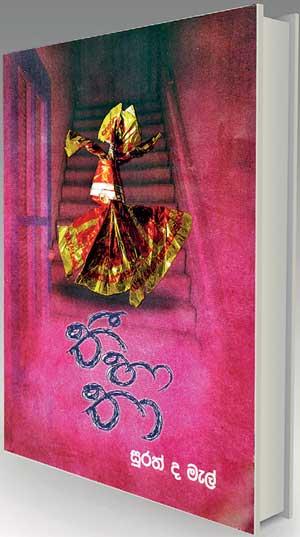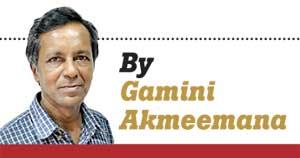25 Nov 2019 - {{hitsCtrl.values.hits}}
Surath de Mel’s Thee Saha Thaa (Thou and Thou) is a remarkable debut novel about the sheer unpredictability and perversity of love in a  specific context.
specific context.
The context is important because one can’t say that love is unpredictable or perverse in general. Depending on the context, it may well turn out to be sublime, romantic, thrilling, fulfilling or heartbreaking and tragic.
Divya and Geeth, the two young lovers in this book, suffer enough heartbreak. But this isn’t in the romantic literary context we are familiar with -- the tradition of Wuthering Heights (Emily Bronte), Anna Karenina (Leo Tolstoi), Crime and Punishment (Fyodor Dostoevsky), Madame Bovary (Gustave Flaubert), A Farewell to Arms (Ernest Hemingway), Tender is the Night (Scott Fitzgerald), The French Lieutenant’s Woman (John Fowles), L’Amant (Marguerite Duras), Ghost at Noon (Alberto Moravia) and A God of Small Things (Arundhati Roy).
"The two young lovers in this book, suffer enough heartbreak. But this isn’t in the romantic literary context we are familiar with"
This list is there to give an idea of how broad the subject is and how different writers have approached it in different eras. These are love stories in different contexts but sharing a romantic outlook. Every book in the above list can be considered a serious treatment of the theme of love, generally above the likes of blockbuster novels such as Gone With The Wind by Margaret Mitchell, no matter how much it may be appreciated by a certain type of reader.
In the annals of Sinhala literature, Karunasena Jayalath’s Golu Hadawatha comes to mind, which cannot be placed in the above list as a literary work, though it has its merits, adequate characterization and a poignant ending.
But while we are discussing here the exposition of romantic love in different contexts, we can take into account a book’s popularity (including its appeal to filmmakers) rather than purely literary merits. In that context, Golu Hadawatha may be the most successful romantic novel we have to date unless I have missed something here (no claims to having read every romantic novel published in Sinhala or, indeed, in English. I am simply going by known parameters).
One may also include a novel such as Chemmeen (published in 1956), the romantic novel on which the successful Malayali film was based, though its author Thakazhi Sivasankara Pillai was exploring the literary possibilities of a myth about chastity among fishermen in Kerala. While God of Small Things explored caste barriers, Chemmeen explored a Hindu-Muslim romance through the miasma of myth.
Where you place these literary works today among the books listed above is a matter of readers’ tastes as well as shifting literary fashions, not to mention publisher’s whims as to which classics would sell and which would not.
This introduction may seem elaborate but is necessary to discussing Surath de Mel’s maiden novel, because the context is vital. Sri Lanka does not have strong traditions in romantic storytelling with love as its theme. Historically, though we have the Kuveni-Vijaya, Digagamani-Unmadachitra legends and the romance between Saliya-Asokamala, we have no literary works in poetry or prose along the lines of Layla and Majnun or Tristan and Isolde. Nor is there a strong tradition of romantic novels in modern Sri Lankan fiction which has left us a body of enduring works. The closest one comes to that is the fiction of W. A. Silva.
 This may pose a problem to any Lankan novelist taking love as his theme. On the other hand, one can also argue he or she has a free playing field to create his own parameters.
This may pose a problem to any Lankan novelist taking love as his theme. On the other hand, one can also argue he or she has a free playing field to create his own parameters.
Surath de Mel clearly works away from the great romantic traditions of world literature. The uncertainties, betrayals and fluctuating mindset of Kavya and Geeth, his two lovers who have a decade-long love affair, belongs to the more clinical and abstract world of postmodernism.
But romantic love is hardly a common theme in post-modernist fiction. If we take one of the better-known names such as Milan Kundera, male-female relationships in his novels are characterised by what would seem a shocking lack of love (in the romantic, realist fiction sense) with greater emphasis on one’s relationship with repressive, and oppressive socio-political systems, and the harsh decisions and sometimes fatal consequences that compromising with such gloomy systems can result in.
"In the end, you feel that Divya and Geeth would gladly trade all their sexual adventures for even a minuscule amount of love"
American novelist Tom Wolfe, in an essay published in 1989, criticised the American literary establishment for moving away from the great literary tradition created by novelists such as Ernest Hemingway, William Faulkner and John Steinbeck. Postmodernism peaked in the West in the 60s and 70s. Cerebral developments arrive late in Sri Lanka, rudely knocked aside in the headlong rush for the latest cars, mobile phones and apps. As such, post-modernism became the rage here in the 1990s. But it hasn’t produced a single notable novel yet.
Surath de Mel’s novel, while it shares some post-modernist elements, cannot be classified as one. While Divya and Geeth betray and hurt each other through their roller-coaster relationship, you can see an unmistakable yearning for old-fashioned romantic love, the one-man one woman-kind, which they can’t quite achieve but long for. This produces a deeply felt pathos. But there is a paradox. While Thee Saha Thaa may not be Post-Modernist in its technique, Divya and Geeth are Post-Modernist characters.
There is an ongoing discussion if Post Modernism has now run its course as a literary style. It’s a safe guess that nine out of ten novels published anywhere in the world today are in more conventional literary formats.
Ultimately, the value of a book is in the characterizations, language, and the power of storytelling. In all three spheres, this debut novel makes its mark (by language I mean the use of dialogue as a means of self-expression, as well as an exposition of the main protagonist’s thought processes).
The story has power because of the pathos in produces in the end. The lives of Divya and Geeth may seem to spin out of control, but are always held in orbit by the gravity of this pathos.
The reader can be appalled by the damage they cause each other even if they can’t see it themselves. Even their sex lives may seem like part of that self-destruction, or the abnegation of romantic love, the ideal they yearn for without acknowledging it.
"Where you place these literary works today among the books listed above is a matter of readers’ tastes as well as shifting literary fashions, not to mention publisher’s whims"
Whether this behaviour is typical of today’s twenty-something generation, or if these two are particularly precocious, it’s hard to say. What the author narrates as youthful pranks, as squeezing the bottoms of passing women while riding bicycles, amounts to sexual harassment.
He writes honestly about sexism, domestic violence and related social problems, though it’s puzzling why he makes no mention of the perverted culture of ragging in our universities when writing about campus life since sexual repression seems to be at the core of a great deal of it.
But what he does tell in the book is more than enough to make Thee Saha Thaa a promising debut novel. In the end, you feel that Divya and Geeth would gladly trade all their sexual adventures for even a minuscule amount of love. But that’s precisely what they can’t get.
28 Nov 2024 5 hours ago
28 Nov 2024 6 hours ago
28 Nov 2024 7 hours ago
28 Nov 2024 8 hours ago
28 Nov 2024 28 Nov 2024